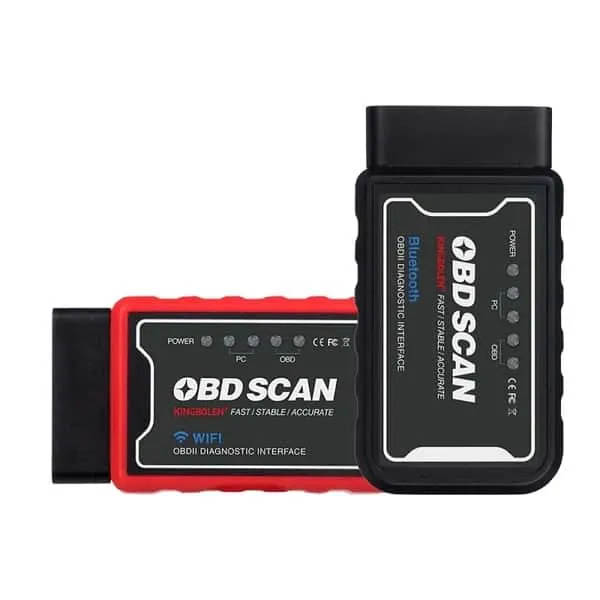If you own a car manufactured after 1996, the OBD2 Scanner is a must-have scanning tool. By performing a quick scan and providing diagnosis reports with error codes such as the P1101 Chevy Cruze code, this tool will end up saving you thousands of dollars. While OBD2 scanners have been around for a while, the Bluetooth OBD2 scanner is a relatively new development.
The Bluetooth version will make your life even more convenient. If you’re interested in this tool, you’re probably considering using an OBD2 Bluetooth scanner. That is exactly why we are here today!
What exactly is a Bluetooth OBD2 Scanner?

As previously stated, an OBD2 scanning tool is required, and we believe that the OBD2 scanner tool is the best of all. You connect it to your car, then to your phone via Bluetooth, and you can run all of the tests right from your fingertips.
You’ll also be able to tell how serious the issues detected are by using the OBD2 Scanner smartphone apps. Unlike traditional OBD2 scan tools, this Bluetooth scanner includes features such as Smart Mechanic to teach you things that only a mechanic would do after inspecting your vehicle.
In addition to diagnostic tests, you can use coding with this advanced Scanner to customize the settings in your car. You will be able to adjust your headlights and turn your car’s automatic on/off system.
You will also be given detailed instructions on what the error codes mean and how to clear them. Furthermore, the Bluetooth scanner app will provide you with useful advice for regular vehicle maintenance.
One of the most useful features is that this app can check live parameters like pressure and temperature, which is extremely useful when diagnosing error codes.
How to Use a Bluetooth OBD2 Scanner
Among all the scanning tools, the OBD2 Bluetooth scanner has to be one of the easiest to use, and they are extremely portable. If you know how to reset the transmission control module, you should have no trouble using this device. These devices are reliable and provide quick scans of your car via the OBD2 system. We’ve written a step-by-step guide to using the OBD2 Scanner down below!
Step 1: Find the OBD2 Port
The OBD2 port, also known as the Diagnostic Link Connector, is easily accessible. It is located on the driver’s side dashboard. It is located on the left side of the dashboard, just below the steering column.
This port is usually covered by something resembling a flap.
Step 2: Connect the OBD2 Scanner to the Port.
Once you’ve located the OBD2 port, simply insert the Bluetooth scanner into it. Make sure you plug it in properly by gently pushing it inside, or else the Scanner will not receive any signals.
Step 3: Start Your Engine or Leave Your Car Idling
Read your Scanner’s user manual to determine whether you must start your car or keep it in idle mode when using the Scanner. This will differ depending on the scanner’s brand. Make sure you follow the correct procedure; if you keep the car in idle mode when the Scanner requires it to be in idle mode, or vice versa, the tool may be damaged.
Step 4: Download the Scanner App and connect it to your phone.
After connecting the OBD2 Scanner and it begins receiving the signal, launch the Scanner application on your phone. You should be able to tell which application you need to install on your phone by reading the user manual, as it varies depending on the brand.
Install the scanner app and enable Bluetooth on your phone. Don’t worry, the app for connecting your phone to the Scanner should be compatible with both iOS and Android devices.
When you open the app on your phone, you should see a ‘connect’ button. After you click that, you must wait a few seconds for the connection with the OBD2 Scanner to be established.
Step 5: Use the App to Run the Scan
You will be able to run OBD2 scans from your phone once the connection has been established. Each application’s user interface will be slightly different, but they will all be very simple, making navigating through the app a breeze.
Step 6: Determine the Meaning of the OBD Error Codes
Following the completion of the scan, OBD2 error codes will be displayed on your phone, and you must understand what they mean in order to proceed with the diagnosis of any issues. Error codes begin with one of four letters: P, B, C, or U, indicating problems in various parts of the car.
Conclusion
The Bluetooth OBD2 is an almost flawless tool that provides utility that no other scanning tool can match. As you can see from our article on how to use the OBD2 Bluetooth scanner, it’s a very user-friendly tool that only takes a few minutes to set up.
Follow all of the steps outlined above, and you’ll be detecting and clearing codes with the OBD2 Bluetooth scanner in no time!
